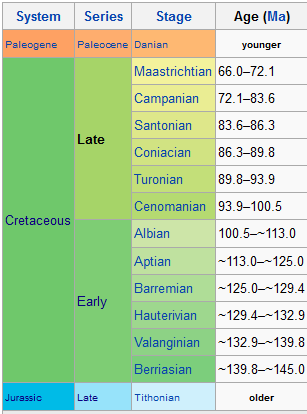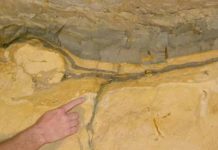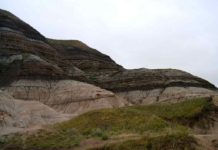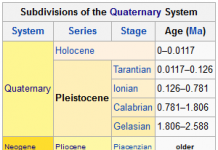
The Late Cretaceous (100.5–66 Ma) is the younger of two epochs into which the Cretaceous period is divided in the geologic timescale. Rock strata from this epoch form the Upper Cretaceous series. The Cretaceous is named after the white limestone known as chalk which occurs widely in northern France and is famously seen in the white cliffs of south-eastern England, and which dates from this time.
Climate
Geography
Vertebrate fauna
Dinosaurs
This was a period of great success for dinosaurs, with many new types appearing and diversifying. The duck bills, Ankylosauridae, and horned dinosaurs experienced success in Asiamerica (Western North America and eastern Asia). Tyrannosaurs dominated the large predator niche in North America.They were also present in Asia, although were usually smaller and more primitive than the North American varieties. Pachycephalosaurs were also present in both North America and Asia. Dromaeosaurs shared the same geographical distribution, and are well documented in both Mongolia and Western North America.By contrast therizinosaurs (known previously as segnosaurs) appear to have been living solely in Asia. Gondwana held a very different dinosaurian fauna, with most predators being abelisaurs and carcharodontosaurs; and titanosaurs being among the dominant herbivores.
Birds
Birds became increasingly common and diverse, replacing the pterosaurs which retreated to increasingly specialised ecological niches.
Mammals
Didelphid marsupials and primitive placental mammals also became common. Still, mammals remained small.
Marine life
In the seas, mosasaurs suddenly appeared and underwent a spectacular evolutionary radiation. Modern sharks also appeared and giant-penguin-like polycotylid plesiosaurs (3 meters long) and huge long-necked elasmosaurs (13 meters long) also diversified. These predators fed on the numerous teleost fishes, which in turn evolved into new advanced and modern forms (Neoteleostei). Ichthyosaurs and pliosaurs, on the other hand, went extinct during the Cenomanian-Turonian anoxic event.
Flora
Cretaceous–Paleogene mass extinction
The Cretaceous–Paleogene extinction event was a large-scale mass extinction of animal and plant species in a geologically short period of time, approximately 66 million years ago (Ma). It is widely known as the K–T extinction event and is associated with a geological signature, usually a thin band dated to that time and found in various parts of the world, known as the Cretaceous–Paleogene boundary (K–T boundary). K is the traditional abbreviation for the Cretaceous Period derived from the German name Kreidezeit, and T is the abbreviation for the Tertiary Period (a historical term for the period of time now covered by the Paleogene and Neogene periods). The event marks the end of the Mesozoic Era and the beginning of the Cenozoic Era. “Tertiary” being no longer recognized as a formal time or rock unit by the International Commission on Stratigraphy, the K-T event is now called the Cretaceous—Paleogene (or K-Pg) extinction event by many researchers.Non-avian dinosaur fossils are only found below the Cretaceous–Paleogene boundary and became extinct immediately before or during the event. A very small number of dinosaur fossils have been found above the Cretaceous–Paleogene boundary, but they have been explained as reworked fossils, that is, fossils that have been eroded from their original locations then preserved in later sedimentary layers.Mosasaurs, plesiosaurs, pterosaurs and many species of plants and invertebrates also became extinct. Mammalian and bird clades passed through the boundary with few extinctions, and evolutionary radiation from those Maastrichtian clades occurred well past the boundary. Rates of extinction and radiation varied across different clades of organisms.
Scientists have hypothesized that the Cretaceous–Paleogene extinctions were caused by one or more catastrophic events such as massive asteroid impacts or increased volcanic activity. Several impact craters and massive volcanic activity in the Deccan traps have been dated to the approximate time of the extinction event. These geological events may have reduced sunlight and hindered photosynthesis, leading to a massive disruption in Earth’s ecology. Other researchers believe the extinction was more gradual, resulting from slower changes in sea level or climate.










